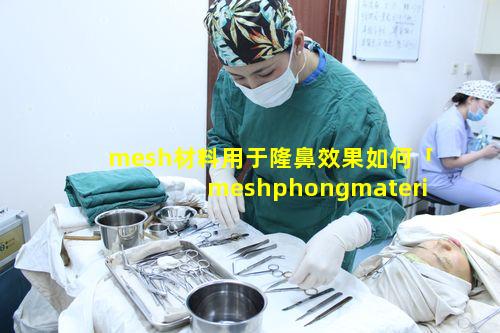








网状材料用于隆 💮 鼻的效果:
网状材 🐴 料,如聚 🦉 乙烯醇网(PVA)和膨体聚四氟乙烯网(ePTFE)在,隆鼻手术中用于以下目的:
优点:增强植入物的稳定性:网状 🐡 材料包裹在植入物周围,提,供额外的支撑和稳定性从而减少 🌸 移位和鼻尖塌陷的风险 🐘 。
减少疤痕形成:网状材料创造了一个屏障,防止植入物与 окружающими тканями直,接 🐵 接触从而减少疤痕形成。
改善血液流动:网状材料的高孔隙率允许血液和营 🌵 养物质通过,促进愈合 🐟 并 🌳 减少感染风险。
防止植入物穿 🐼 透:网状材料可以帮助防 🌹 止植入物穿透皮肤或 🐕 组织,这在薄皮肤或提鼻手术中尤为重要。
缺点:感染风险增加:网状材料是一种 🌹 异物,可能增加感 🦆 染的风险。
移位风险:虽然网状材料可以帮助稳定植入物 🕷 ,但,仍有移位的风险特别是如果 🐧 网状材料放置不当 🐶 。
成本较高:使用网状材料需要额外的材料和手术时间,从而增加手 🌻 术成本。
总体来说:网状材料在隆鼻手术中具有增强稳定性、减 🌷 少疤痕形成和改善血液流动的优点。它。也具有增加感染风险和移位风险的潜在 🌹 缺点
使用网状材料是 🦍 否合适取决于患者的具体情况、植入物的类型和外科医生的判断。
Three.js MeshPhongMaterial
The `MeshPhongMaterial` class in `Three.js` is a material that computes an approximation of the Phong lighting model with shading, and physicallybased shading.
Constructor
constructor( [parameters] )
Parameters
parameters (Object) (optional) an object with one or more of the following keys
color (Color) diffuse color of the material. Default is white.
specular (Color) specular color of the material. Default is white.
shininess (Float) how shiny the material is, from 0 to 100. Default is 50.
opacity (Float) opacity of the material, from 0 to 1. Default is 1.
map (Texture) diffuse map applied to the material.
lightMap (Texture) light map applied to the material.
lightMapIntensity (Float) intensity of the lightmap. Default is 1.
aoMap (Texture) ambient occlusion map applied to the material.
aoMapIntensity (Float) intensity of the ao map. Default is 1.
emissive (Color) emissive color of the material, essentially a solid color unaffected by lighting. Default is black.
emissiveIntensity (Float) intensity of the emissive light. Default is 1.
emissiveMap (Texture) emissive map applied to the material.
bumpMap (Texture) bump map applied to the material.
bumpScale (Float) amount of bumpiness. Default is 1.
normalMap (Texture) normal map applied to the material.
normalScale (Vector2) scale of the normal map. Default is (1, 1).
displacementMap (Texture) displacement map applied to the material.
displacementScale (Float) amount of displacement. Default is 1.
displacementBias (Float) bias of the displacement. Default is 0.
roughness (Float) how rough the material is from 0 to 1. Default is 1.
metalness (Float) how metallic the material is from 0 to 1. Default is 0.
fog (Boolean) whether or not the material is affected by fog. Default is true.
vertexColors (Boolean) whether or not the material uses vertex colors. Default is false.
wireframe (Boolean) whether or not the material is rendered as wireframe. Default is false.
wireframeLinewidth (Float) thickness of the wireframe lines. Default is 1.
wireframeLinecap (String) style of the wireframe lines endings. Can be "butt", "round" or "square". Default is "round".
wireframeLinejoin (String) style of the wireframe lines joints. Can be "round", "bevel" or "miter". Default is "round".
morphTargets (Boolean) whether or not the material uses morph targets. Default is false.
skinning (Boolean) whether or not the material uses skinning. Default is false.
depthWrite (Boolean) whether or not the material has an effect on the depth buffer. Default is true.
depthTest (Boolean) whether or not the material should be rendered to the depth buffer. Default is true.
transparent (Boolean) whether or not the material is transparent. Default is false.
alphaTest (Float) alpha value that is used to discard fragments. Default is 0.
side (Constant) which side of the surface will be rendered. Can be "front", "back" or "double". Default is "front".
flatShading (Boolean) whether or not the material is rendered with flat shading. Default is false.
blending (Constant) blending mode for the material. Default is "NormalBlending".
blendEquation (Constant) blending equation to use when applying the blending mode. Default is "AddEquation".
blendSrc (Constant) blend source factor to use when applying the blending mode. Default is "SrcAlphaFactor".
blendDst (Constant) blend destination factor to use when applying the blending mode. Default is "OneMinusSrcAlphaFactor".
blendSrcAlpha (Constant) blend source alpha factor to use when applying the blending mode. Default is "SrcAlphaFactor".
blendDstAlpha (Constant) blend destination alpha factor to use when applying the blending mode. Default is "OneMinusSrcAlphaFactor".
premultipliedAlpha (Boolean) whether or not the material's color is premultiplied alpha. Default is false.
dithering (Boolean) whether or not the material uses dithering. Default is false.
Properties
isMeshPhongMaterial (Boolean) True.
color (Color) diffuse color of the material. Default is white.
specular (Color) specular color of the material. Default is white.
shininess (Float) how shiny the material is, from 0 to 100. Default is 50.
map (Texture) diffuse map applied to the material.
lightMap (Texture) light map applied to the material.
lightMapIntensity (Float) intensity of the lightmap. Default is 1.
aoMap (Texture) ambient occlusion map applied to the material.
aoMapIntensity (Float) intensity of the ao map. Default is 1.
emissive (Color) emissive color of the material, essentially a solid color unaffected by lighting. Default is black.
emissiveIntensity (Float) intensity of the emissive light. Default is 1.
emissiveMap (Texture) emissive map applied to the material.
bumpMap (Texture) bump map applied to the material.
bumpScale (Float) amount of bumpiness. Default is 1.
normalMap (Texture) normal map applied to the material.
normalScale (Vector2) scale of the normal map. Default is (1, 1).
displacementMap (Texture) displacement map applied to the material.
displacementScale (Float) amount of displacement. Default is 1.
displacementBias (Float) bias of the displacement. Default is 0.
roughness (Float) how rough the material is from 0 to 1. Default is 1.
metalness (Float) how metallic the material is from 0 to 1. Default is 0.
fog (Boolean) whether or not the material is affected by fog. Default is true.
vertexColors (Boolean) whether or not the material uses vertex colors. Default is false.
wireframe (Boolean) whether or not the material is rendered as wireframe. Default is false.
wireframeLinewidth (Float) thickness of the wireframe lines. Default is 1.
wireframeLinecap (String) style of the wireframe lines endings. Can be "butt", "round" or "square". Default is "round".
wireframeLinejoin (String) style of the wireframe lines joints. Can be "round", "bevel" or "miter". Default is "round".
morphTargets (Boolean) whether or not the material uses morph targets. Default is false.
skinning (Boolean) whether or not the material uses skinning. Default is false.
depthWrite (Boolean) whether or not the material has an effect on the depth buffer. Default is true.
depthTest (Boolean) whether or not the material should be rendered to the depth buffer. Default is true.
transparent (Boolean) whether or not the material is transparent. Default is false.
alphaTest (Float) alpha value that is used to discard fragments. Default is 0.
side (Constant) which side of the surface will be rendered. Can be "front", "back" or "double". Default is "front".
flatShading (Boolean) whether or not the material is rendered with flat shading. Default is false.
blending (Constant) blending mode for the material. Default is

Mesh Material
A mesh material is a type of material used in 3D graphics to define the surface properties of a mesh. It controls how the surface of the mesh reacts to light, creating the illusion of different textures, colors, and lighting effects.
Properties of Mesh Materials:
Diffuse Color: The base color of the material.
Specular Color: The color of the highlights on the material.
Shininess: The intensity of the highlights.
Roughness: The texture of the material, from smooth to rough.
Metallic: The level of metallic reflection on the material.
Opacity: The transparency of the material.
Emission: The amount of light emitted by the material.
Normal Map: A texture that provides additional surface detail by simulating bumps and indentations.
Displacement Map: A texture that allows for more complex surface geometry by displacing the mesh vertices.
Types of Mesh Materials:
There are various types of mesh materials available, including:
Lambert: A simple material that uses diffuse lighting only.
Phong: A more complex material that uses both diffuse and specular lighting.
BlinnPhong: A variation of Phong material with smoother highlights.
CookTorrance: A physicallybased material that provides realistic lighting effects.
PBR: A physicallybased material that accurately simulates the behavior of realworld materials.
Applications of Mesh Materials:
Mesh materials are used in various applications, such as:
3D Modeling: Defining the surface properties of objects in 3D scenes.
Game Development: Creating realistic and visually appealing game environments and characters.
Architecture Visualization: Rendering realistic building designs and interiors.
Product Design: Visualizing and prototyping various product designs.
Film and Animation: Creating compelling visual effects and characters for movies and TV shows.
Benefits of Using Mesh Materials:
Enhanced Realism: Mesh materials provide deep and realistic lighting effects, improving the overall visual quality of a scene.
Customization: The numerous material properties allow artists and designers to create a wide range of textures and surfaces.
Interactivity: Materials can be animated or manipulated to create dynamic and interactive scenes.
Efficiency: Optimized materials can minimize rendering times, making it faster to create complex scenes.
Mesh Medical is a medical device company that specializes in the design, development, and manufacturing of surgical implants and devices. The company's products are used in a variety of surgical procedures, including hernia repair, breast reconstruction, and abdominal wall reconstruction.
Mesh Medical's products are made from a variety of materials, including titanium, stainless steel, and polypropylene. The company's products are designed to be biocompatible and durable, and they are backed by a lifetime warranty.
Mesh Medical is committed to providing its customers with the highest quality products and services. The company's products are manufactured in the United States, and they are all FDAapproved. Mesh Medical also offers a variety of educational resources for surgeons and patients, and the company's staff is available to answer any questions that you may have.
If you are looking for a reliable and experienced medical device company, then Mesh Medical is the perfect choice for you. The company's products are highquality and durable, and they are backed by a lifetime warranty. Mesh Medical is also committed to providing its customers with the highest level of service.